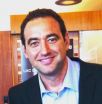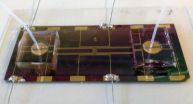(Press-News.org) Smartphones are capable of giving us directions when we're lost, sending photos and videos to our friends in mere seconds, and even helping us find the best burger joint in a three-mile radius. But University of Houston researchers are using smartphones for another very important function: diagnosing diseases in real time.
The researchers are developing a disease diagnostic system that offers results that could be read using only a smartphone and a $20 lens attachment.
The system is the brainchild of Jiming Bao, assistant professor of electrical and computer engineering, and Richard Willson, Huffington-Woestemeyer Professor of Chemical and Biomolecular Engineering. It was created through grants from the National Institutes of Health and The Welch Foundation, and was featured in February in ACS Photonics.
This new device, like essentially all diagnostic tools, relies on specific chemical interactions that form between something that causes a disease – a virus or bacteria, for example – and a molecule that bonds with that one thing only, like a disease-fighting antibody. A bond that forms between a strep bacteria and an antibody that interacts only with strep, for instance, can support an ironclad diagnosis.
The trick is finding a way to detect these chemical interactions quickly, cheaply and easily. The solution proposed by Bao and Willson involves a simple glass slide and a thin film of gold with thousands of holes poked in it.
Creating this slide is itself an achievement. This task, led by Bao, starts with a standard slide covered in a light-sensitive material known as a photoresist. He next uses a laser to create a series of interference fringes – basically lines – on the slide, and then rotates it 90 degrees and creates another series of interference fringes. The intersections of these two sets of lines creates a fishnet pattern of UV exposure on the photoresist. The photoresist is then developed and washed away.
While most of the slide is then cleared, the spots surrounded by intersecting laser lines – the 'holes' in the fishnet – remain covered, basically forming pillars of photoresist.
Next, he exposes the slide to evaporated gold, which attaches to photoresist and the surrounding clean glass surface. Bao then performs a procedure called lift-off, which essentially washes away the photoresist pillars and the gold film attached to them.
The end result is a glass slide covered by a film of gold with ordered rows and columns of transparent holes where light can pass through.
These holes, measuring about 600 nanometers each, are key to the system. Willson and Bao's device diagnoses an illness by blocking the light with a disease-antibody bond – plus a few additional ingredients.
Here is where Willson comes in. An internationally known biomolecular engineer, Willson starts by placing disease antibodies in the holes, where they are coaxed into sticking to the glass surface. Next, he flows a biological sample over the slide. If the sample contains the bacteria or virus being sought out, it will bond with the antibody in the hole.
This bond alone, though, doesn't block the light. "The thing that binds to the antibody is probably not big and grey enough to darken this hole, so you have to find a way to darken it up somehow," Willson said.
Willson achieves this by flowing a second round of antibodies that bond with the bacteria over the slide. Attached to these antibodies are enzymes that produce silver particles when exposed to certain chemicals. With this second set of antibodies now attached to any bacteria in the holes, Willson then exposes the entire system to the chemicals that encourage silver production.
About 15 minutes later he rinses off the slide. Thanks to chemical properties of the gold, the silver particles in the holes will remain in place, completely blocking light.
Here's where the smart phone comes in. One of the advantages of this system is that the results can be read with simple tools. A basic microscope used in elementary school classrooms, Willson said, provides enough light and magnification to show whether the holes are blocked. With a few small tweaks, a similar reading could almost certainly be made with a phone's camera, flash and an attachable lens.
This system, then, promises readouts that are affordable and easy to interpret.
"Some of the more advanced diagnostic systems need $200,000 worth of instrumentation to read the results," said Willson. "With this, you can add $20 to a phone you already have and you're done."
There are still major technical hurdles to clear before the system can be rolled out, Willson noted. One of the biggest challenges is finding a way to drive the bacteria and viruses in the sample down to the surface of the slide to ensure the most accurate results.
But if those problems are overcome, the system would be an excellent tool for healthcare providers in the field.
At the site of an industrial accident, for instance, the holes on a single slide could be populated with molecules that bond with 10 potential contaminants, allowing response teams to quickly assess the situation. In economically disadvantaged areas, such a system could be used to screen large groups of people for widespread and serious health problems, like diabetes.
"There are a lot of situations where an affordable diagnostic tool that is simple to use and simple to interpret could be very useful," said Willson. "If both your disposables and your reader are cheap, that makes it a lot easier to extend your system out into the real world."
INFORMATION:
-- By Toby Weber
Diagnosing diseases with smartphones
Researchers at UH are developing a system to use smartphones to diagnose diseases in real time
2014-03-10
ELSE PRESS RELEASES FROM THIS DATE:
Loss of antioxidant protein Nrf2 represses regeneration of muscle lost to aging
2014-03-10
(SALT LAKE CITY)—Good news for lifelong exercisers: Along with its salutary effects on the heart, weight, and other facets of health, physical activity also helps to regenerate muscle mass, which tends to diminish as people age.
In a study published in the journal Free Radical Biology and Medicine, researchers from the University of Utah and other institutions found that aged mice lacking Nrf2 that underwent two weeks of endurance exercise stress on treadmills showed poor stem cell regeneration, which is likely to hinder the recovery of lost muscle mass. Nrf2 is protein ...
Scents and sustainability
2014-03-10
Fresh banana, a waft of flowers, blueberry: the scents in Shota Atsumi's laboratory in the UC Davis Department of Chemistry are a little sweeter than most. That's because Atsumi and his team are engineering bacteria to make esters -- molecules widely used as scents and flavorings, and also as basic feedstock for chemical processes from paints to fuels.
Their latest work is published March 9 in the journal Nature Chemical Biology.
Nearly all industrial chemicals, from artificial flavorings to paint, are derived from oil or gas, Atsumi said.
"Our motivation is to ...
Blind can 'hear' colors and shapes, show Hebrew U. researchers
2014-03-10
Jerusalem, March 9, 2014 -- What if you could "hear" colors? Or shapes? These features are normally perceived visually, but using sensory substitution devices (SSDs) they can now be conveyed to the brain noninvasively through other senses.
At the Center for Human Perception and Cognition, headed by Prof. Amir Amedi of the Edmond and Lily Safra Center for Brain Sciences and the Institute for Medical Research Israel-Canada at the Hebrew University of Jerusalem Faculty of Medicine, the blind and visually impaired are being offered tools, via training with SSDs, to receive ...
Biomolecular tweezers facilitate study of mechanical force effects on cells and proteins
2014-03-10
A new type of biomolecular tweezers could help researchers study how mechanical forces affect the biochemical activity of cells and proteins. The devices – too small to see without a microscope – use opposing magnetic and electrophoretic forces to precisely stretch the cells and molecules, holding them in position so that the activity of receptors and other biochemical activity can be studied.
Arrays of the tweezers could be combined to study multiple molecules and cells simultaneously, providing a high-throughput capability for assessing the effects of mechanical forces ...
These aren't the voids you're looking for
2014-03-10
Australian astronomers have shown galaxies in the vast empty regions of the Universe are actually aligned into delicate strings in research published today in the Monthly Notices of the Royal Astronomical Society.
A team of astronomers based at The University of Western Australia node of the International Centre for Radio Astronomy Research (ICRAR) has found short strings of faint galaxies in what were previously thought to be extremely empty parts of space.
The Universe is full of vast collections of galaxies that are arranged into an intricate web of clusters and ...
A tricky balancing act: Antibiotics versus the gut microbiota
2014-03-10
(March 10, 2014) Antibiotics are valuable, potentially life-saving tools that have significantly reduced human morbidity and mortality. Unfortunately, antibiotics may also have unintended consequences from their off-target effects that may increase the risk of many long-term conditions. Recent epidemiologic studies have detected a possible link between antibiotic use in childhood and weight gain1 — with disruption to the normal gut microbiota considered the most likely cause.
"Infancy is an important time in the development of the human microbiota and these studies provide ...
Feeding gut microbiota: Nutrition & probiotics are key factors for digestive health
2014-03-10
(March 10, 2014) A healthy and balanced diet, as well as probiotics, have been known to be helpful in preserving gastrointestinal health for quite a long time. But it is only recently that the underlying mechanisms have become somewhat clearer. A rapidly increasing body of knowledge promises to further clarify the effects of our daily food on the gut microbiota and to indicate more targeted applications of probiotics in the near future. This was one of the topics presented at the Gut Microbiota for Health World Summit in Miami, FL, USA. On March 8-9, 2014, internationally ...
Lower IQ in teen years increase risk of early-onset dementia
2014-03-10
Men who at the age of 18 years have poorer cardiovascular fitness and/or a lower IQ more often suffer from dementia before the age of 60. This is shown in a recent study encompassing more than one million Swedish men.
In several extensive studies, researchers at the Sahlgrenska Academy of Gothenburg University have previously analyzed Swedish men's conscription results and were able to show a correlation between cardiovascular fitness as a teenager and health problems in later life.
Increased risk for early-onset dementia
In their latest study, based on data from 1.1 ...
Healthy eating may reduce the risk of preterm delivery
2014-03-10
In the study, which was conducted by researchers from the University of Gothenburg, Sahlgrenska University Hospital and the Norwegian Institute of Public Health, the participants completed a scientifically evaluated questionnaire about what they had been eating and drinking since becoming pregnant.
The researchers also had access to information about the women's general lifestyle e.g. level of education, living conditions, income, weight, physical activity, smoking habits, alcohol consumption, number of children and medical factors such as history of preterm delivery.
15 ...
Computer system simulates the behavior of tax evaders
2014-03-10
Tax fraud is a very serious problem for society, especially in Spain, where tax evasion represents almost one-fourth of its Gross Domestic Product. On the one hand, evasion is a problem because it produces a loss in public resources, something which is especially difficult in a time of economic crisis with cutbacks in public funding; on the other hand, tax fraud damages the effectiveness of justice within the tax system, since not everyone is able to evade taxes equally, thus leading to injustices between small and large companies and between the self-employed and employees. ...
LAST 30 PRESS RELEASES:
Danforth Plant Science Center to lead multi-disciplinary research to enhance stress resilience in bioenergy sorghum
Home-delivered groceries improve blood sugar control for people with diabetes facing food insecurity
MIT researchers identified three cognitive skills we use to infer what someone really means
The Iberian Peninsula is rotating clockwise according to new geodynamic data
SwRI, Trinity University to study stable bacterial proteins in search of medical advances
NIH-led study reveals role of mobile DNA elements in lung cancer progression
Stanford Medicine-led study identifies immune switch critical to autoimmunity, cancer
Research Alert: How the Immune System Stalls Weight Loss
Glucagon-like peptide 1 receptor agonist use and vertebral fracture risk in type 2 diabetes
Nonadherence to cervical cancer screening guidelines in commercially insured US adults
Contraception and castration linked to longer lifespan
An old jeweler’s trick could unlock next-generation nuclear clocks
Older age, chronic kidney disease and cerebrovascular disease linked with increased risk for paralysis and death after West Nile virus infection
New immune role discovered for specialized gut cells linked to celiac disease
A new ‘hypertropical’ climate is emerging in the Amazon
Integrated piezoelectric vibration and in situ force sensing for low-trauma tissue penetration
Three-hit model describes the causes of autism
Beech trees use seasonal soil moisture to optimize water uptake
How thinning benefits growth for all trees
Researchers upgrades 3-PG forest model for improved accuracy
Achieving anti-thermal-quenching in Tb3+-doped glass scintillators via dual-channel thermally enhanced energy transfer
Liquid metal modified hexagonal boron nitride flakes for efficient electromagnetic wave absorption and thermal management
Failure mechanisms in PEM water electrolyzers
Study captures how cancer cells hide from brain immune cells, shows that removing their “don’t eat me” signals stops their escape
New breakthrough in detecting ‘ghost particles’ from the Sun
Half of people arrested in London may have undiagnosed ADHD, study finds
From dots to lines: new database catalogs human gene types using ’ACTG’ rules
Persistent antibiotic resistance of cholera-causing bacteria in Africa revealed from a multinational workshop for strengthening disease surveillance
SwRI, Trinity University to synthesize novel compound to mitigate effects of stroke, heart attack
Novel endocrine therapy giredestrant improves disease-free survival over standard of care for patients with early-stage breast cancer in phase III lidERA trial
[Press-News.org] Diagnosing diseases with smartphonesResearchers at UH are developing a system to use smartphones to diagnose diseases in real time






